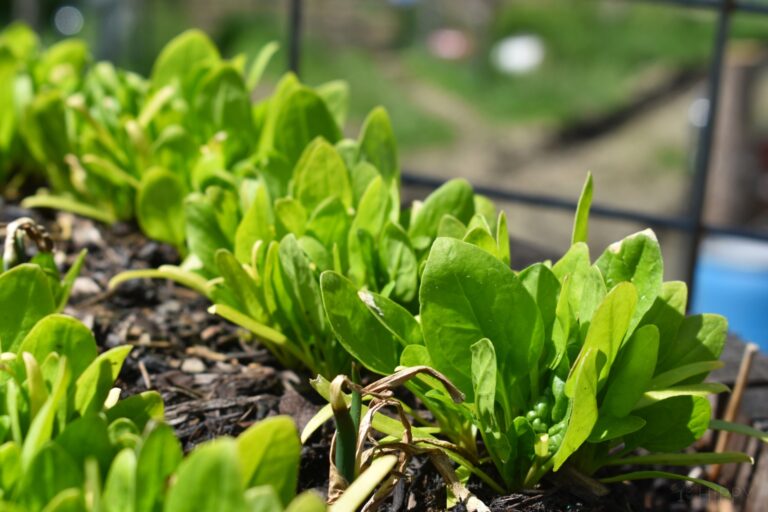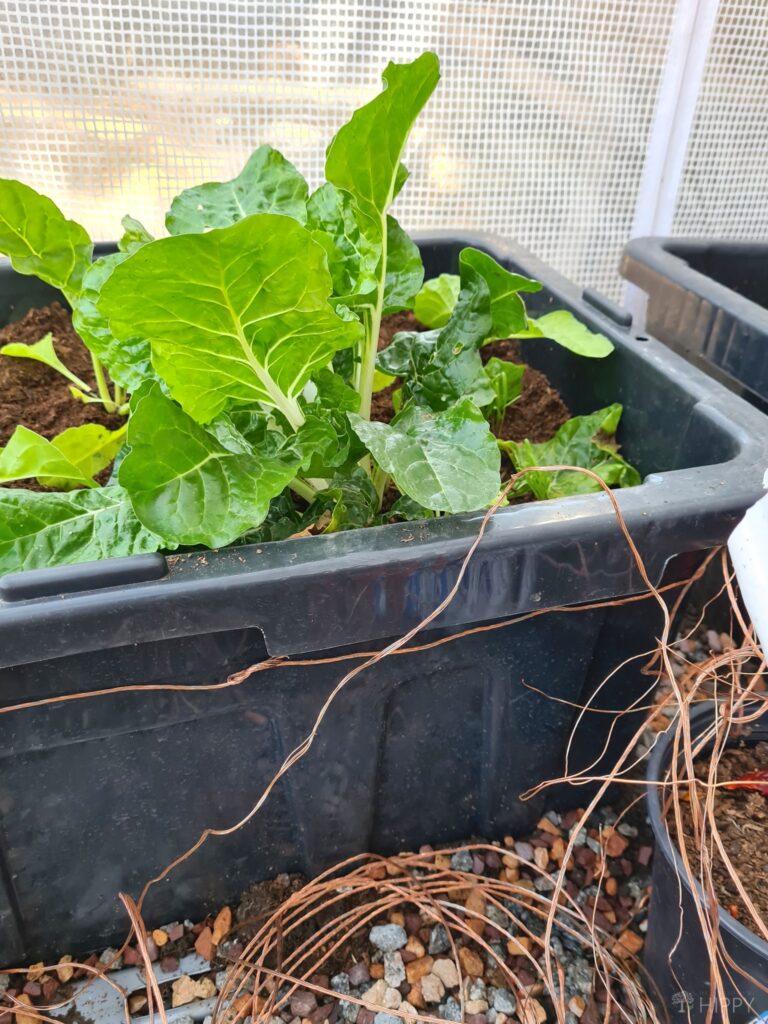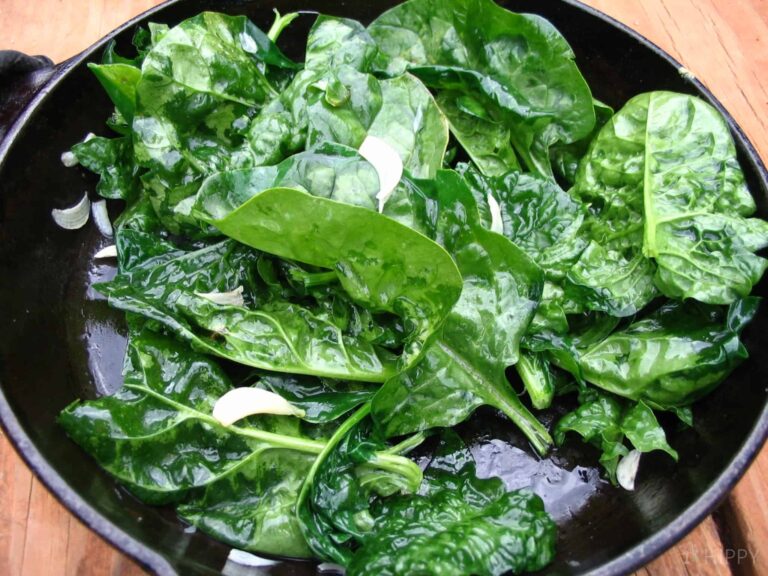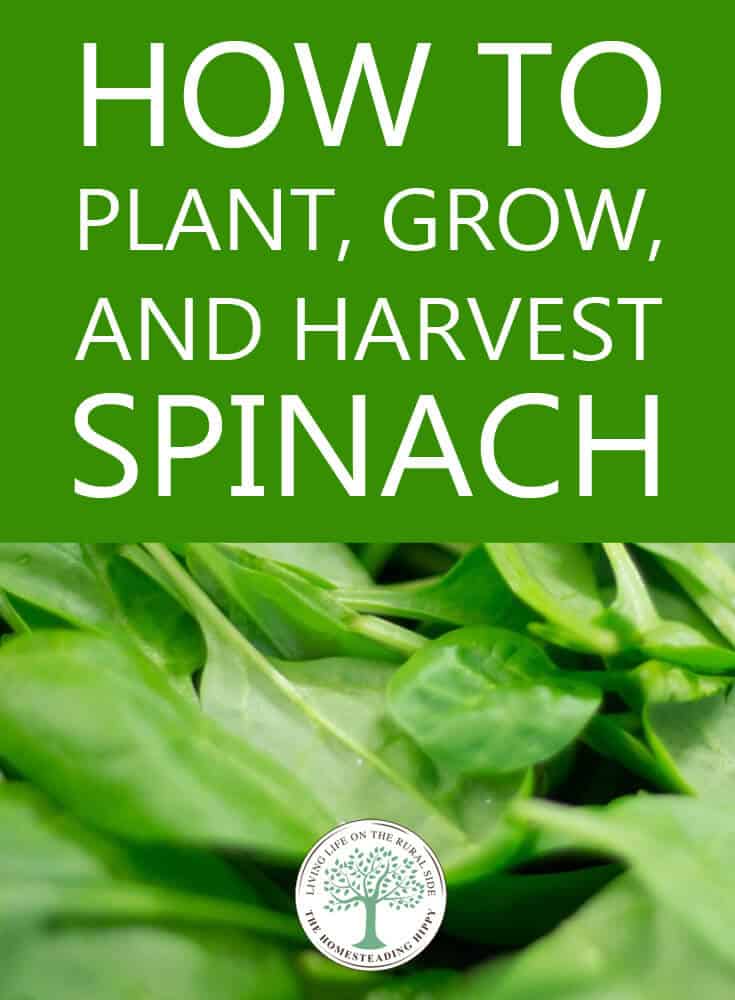The health benefits of spinach were caricatured by the super strength of Popeye the Sailor Man cartoons in the early 1930s.
A can of spinach provided the hero with a burst of super strength to defeat the villain and save the love of his life, Olive Oil.

Obviously, in real life, we will not be able to achieve instant super strength from eating a can of spinach.
However, spinach is worth adding to your diet because it is loaded with vitamins and minerals such as B Vitamins, Vitamin C, Vitamin A, folate, iron, calcium, magnesium, and potassium, so growing it in your garden may be one of the best you can do for your long-term health.
This low calorie, nutrient dense vegetable may protect your heart health, fight acne and GERD, and improve bone and skin health. At only 7 calories per cup, you can fill up on tasty spinach without blowing your entire diet.
Spinach has a long history of being cultivated even before it became popular in the United States.
Spinach most likely originated in Persia, and then was introduced to Europe around 1000 AD. It was later established in France and England and finally brought to the Americas by the Spanish.
Spinach, also known as spinacea oleracia, is best fresh, although it can also be used from frozen. Gardeners love planting spinach because it is easy to grow and quick to mature. It can be served fresh, canned, cooked, and frozen.
Spinach makes a great addition to egg dishes and salads. It is easy to find varieties that will suit your climate and your diet needs.
Best Types of Spinach to Plant
There are three main types of spinach that are popular to grow. You may want to try all three varieties in order to find the one that best suits your taste, garden, and climate. Look for spinach that is slow to bolt if you are growing in hotter areas or seasons.
Spinach that is quick to bolt is well-suited for early and late plantings and areas with cooler summers. Quick-growing, quick-to-bolt spinach has a sweeter taste when grown in cool weather.
Surprisingly, one of the largest factors in choosing spinach is the texture of the leaves. While smoother leaves are easier to wash, savoyed or crinkly, rumpled leaves look beautiful and taste delicious, but are difficult to clean.
Many spinach varieties on the market are hybrids which are cultivated to be more resistant to bolting and disease.
Flat-leaf Spinach
Flat leaf spinach is the most popular type of spinach to grow. It bears smooth flat leaves that are the easiest type of leaf to clean.
This type of spinach is great for large scale production and sales at farmers’ markets. It is a variety frequently found in supermarkets and grocery stores.
Savoy spinach
Savoy spinach is also known as a curly leaf spinach. This type of spinach is very productive and grows well in cold weather. The deeply crinkled leaves of this spinach look pretty but are more difficult to clean.
This type of spinach tends to grow close to the ground where it picks up dirt and grit from rain and irrigation splashes. Triple wash this type of spinach to make sure to remove all compost, dirt, grit, and bugs.
Semi-savoy Spinach
Semi-savoy spinach is a less crinkled variety of spinach then savoy. This spinach grows more upright, which means it picks up less dirt.
The crinkles in this spinach are not as deep, making it easier to clean. This spinach is also more disease and bolt resistant than savoy spinach, making it a great all-around variety for the typical gardener.
Individual Varieties of Spinach
Savoy Spinach:
- Regiment Spinach. Regiment spinach cultivates well in cool soils, making it a terrific variety for early spring and late fall. The thick, broad leaves are arrow shaped. This quick-maturing variety is ready in just thirty seven days.
- Bloomsdale LongStanding Spinach. Bloomsdale Long Standing Spinach boasts glossy, dark green leaves. This variety grow wonderfully in early spring and late fall. It is a strong producer that is slow to bolt. This variety grows ten to twelve inches tall and is ready to eat in forty to forty four days.
- Coho Spinach. Coho spinach was a popular variety of spinach that was highly resistant to white rust, a common spinach disease. Coho has been discontinued and replaced by Ashely Spinach.
Semi-savoy Spinach:
- Tyee Spinach. Tyee spinach is both heat and cold weather hardy, making it a great contender for all season planting. This variety of spinach is also disease and bolt-resistant, and matures in as little as forty five days.
- Catalina Spinach. This spinach is a bolt-resistant, fast grower. It grows a nicely shaped, crunchy leaf and is best served as baby spinach. Catalina spinach boasts a mild and nutty flavor and matures in forty eight days.
- Teton Spinach. Teton spinach is a hybrid variety that grows upright. It is very productive and slow to bolt. This type of spinach matures in as little as forty to forty five days.
- Indian Summer Spinach. If you need a spinach that will perform all summer long, choose Indian Summer Spinach. This spinach is very productive, easy to grow even in the long summer days, and tastes great. This disease resistant hybrid matures in thirty five to forty days.
- Ashley Spinach. Ashley is a commercially tested variety of semi-savoy spinach that is disease and drought tolerant. Ashley has performed well in the cooler season of South Central Texas.
Flat-leaf Spinach:
- Space Spinach. Space spinach is a smooth-leaved hybrid that is resistant to downy mildew. The upright leaves are a rich green color. This spinach matures in just twenty five days.
- Red Cardinal Spinach. The smooth leaves of red cardinal spinach grow upright and are easy to clean. This spinach looks great in salads with its sweet green leaves and red stems. Red Cardinal spinach works best when served as baby spinach. Plant this variety in the spring and summer due to its tendency to bolt. In the fall, grows to maturity in twenty five to thirty five days.
- Kolibri Spinach. This spinach can be grown intensively for baby leaf production, as it takes on 29 days to reach maturity. This variety is also pretty resistant to downy mildew.
- Reflect Spinach. Reflect is a fast growing spinach and reaches maturity at twenty eight days. The leaves grow somewhat upright and could also be classified as a semi-savoy spinach. This spinach can be sown all season long, from spring through winter.
- Giant Noble Spinach. Giant noble spinach is popular with cooks and gardeners alike. This giant spinach has a spread of up to twenty five inches. Although technically a flat-leaf spinach, the large leaves are slightly savoyed and will remain tender even though the leaves and stems are large. This spinach is easy to grow and slow to bolt. This open pollinated heirloom spinach matures in forty six days.
- Olympia Spinach. Olympia spinach is one of the best for year round sowing and harvesting. It is highly productive, dark leafy green, and slow to bolt. It can reach a size of ten inches and matures in forty five days.
- Viroflay Spinach. Viroflay spinach is a french heirloom spinach. It’s large leaves can grow up to ten inches and boast a deep green color. Viroflay matures in fifty days and was developed before 1866.
When to Plant Spinach
Generally speaking, spinach is a cool weather crop. This means most varieties of spinach will grow fastest and best in the cooler weather of spring and fall. Most varieties of spinach do not do well in the heat of the summer when they are more susceptible to downy mildew and bolting.
Bolting will cause spinach to become bitter or tasteless. Spinach will generally germinate in soil temperatures between 40 and 75 degrees F (5 to 25 degrees C).
The higher the temperature, the faster the germination, but the lower the germination rate.
Because spinach is so tolerant of cool weather, you can plant your seeds in the spring as soon as the soil is soft enough to be worked. This means you will probably be able to plant your spinach seeds in your garden as early as six weeks before the last frost date.
At the end of the summer season, you can plant your spinach six to eight weeks before the first frost date for a fall and winter crop of spinach.
Spinach is very frost tolerant, and a light frost may even improve the taste and texture of this vegetable.
Mature plants may be able to tolerate temperatures as low as 20 degrees Fahrenheit (-7 Celsius), although a hard freeze may kill tender plants. For best results, use a row cover to prevent a damaging freeze.
Succession Planting
Succession planting means staggering the planting times of your seeds, rather than planting them all at once. Spinach is a great plant to succession plant because some varieties do better in cool weather, and some will also grow in warmer weather. I
n early spring, as soon as the ground can be worked, begin planting your cool weather varieties of spinach, planting a new row every week to two weeks.
After that, as the weather begins to warm, begin planting warm weather varieties of spinach, continuing to plant a new row every week to two weeks.
Remember that germination goes down in warm weather, so you will need to plant extra seeds to get the same number of plants to grow.
As the end of August nears, you can begin planting cooler weather spinach varieties again. This time, you will need to water frequently to cool the soil until the air temperatures begin to drop.
The slower growing types of spinach will grow better in warmer weather, while the faster growing types of spinach will do better in the cooler weather. Consider using a shade cloth or companion planting to extend your growing season in the summer.
Spinach that is mature by the time winter sets in can be overwintered in a greenhouse or a hoophouse, provided it is matured by the time daylight shortens to ten hours a day. At this point, growth will slow or stop, but plants will survive the cold if they are protected.
You can continues to harvest your spinach throughout the winter and into early spring. If you successfully succession plant throughout spring and summer, you will have spinach to eat most of the year round.
Where to Plant Spinach
Spinach thrives in cool temperatures and full sun, but it will also do well in light shade. Plant spinach in a sunny area of your garden. You can plant it alongside crops that will grow taller, giving it shade by the time the temperatures begin to warm.
This will keep the spinach cooler. Also, the lengthening amount of daylight will trigger bolting, so when your spinach plants receive less direct sun, they will be less likely to bolt or taste bitter.
Another consideration in deciding where to plant spinach is to put it where the soil will drain well. In the warmer months, you will need to water the spinach more often so that the soil will cool. However, spinach does not grow well in soggy soil, so plant where the soil also has good drainage.
Warm weather varieties of spinach can be successfully grown in containers. However, spinach grows a tap root that can grow up to a foot long, so be sure your pot is deep enough and wide enough so as not to crowd your plants.
How to Plant Spinach
Spinach does not transplant well, so it is best to direct sow your spinach seeds into rich, organic garden soil.
- Plant your spinach seeds 1/2 to 1 inch deep and no more than twelve to fifteen seeds per foot of garden row.
- Space rows approximately one foot apart.
- Cover seeds lightly with soil and water carefully.
- Thin seedlings to four inches apart in order to optimize growth.
Tips for Growing Spinach
Lengthening days and warm weather causes spinach to bolt and become bitter. You can stave off bolting a bit by planting your spinach in the shade of taller crops in warmer weather, such as celery, eggplant, or even cauliflower.
These vegetables make good companion crops for spinach and will help them grow better.
Under the right conditions, seeds will germinate in 5 to 9 days as long as it is not too hot or too cold. It is harder to get the seeds to germinate in the hot days of summer since the germination rate drops below 50%.
You can improve germination by planting your spinach seeds in the shade or taller plants and by cooling the soil.
Cool the soil by watering frequently, just make sure the soil is draining well and evaporating. Soggy soil is not good for spinach plants.
Spinach thrives on nitrogen. If you fertilize your spinach plants, use a nitrogen based fertilizer to give your plants a boost. When planting, use lots of compost in the row where you will be planting your spinach for faster growth. Keep your soil neutral to slightly alkaline.
Because spinach is mostly a cool weather crop, you can avoid many of the pests that attack lettuces and other salad greens.
However, spinach is susceptible to downy mildew, fungi, root rot, fusarium wilt, and white rust. The best way to prevent these problems is to plant varieties of spinach that have been bred to be resistant.
Avoid overwatering to prevent root rot and fusarium wilt, and be sure to water your spinach plants at the base of the plant rather than from overhead.
Downy mildew presents as yellowing spots on the leaves of spinach plants, and blue to purple mold on the undersides of the leaves.
Leaves may eventually curl and wilt. White rust shows up as yellow spots on the leaves and white pustules on the under side of leaves. Fungicides may help in the earlier states of infection, but the best defense is to plant disease resistant varieties of spinach.

A few pests that may cause trouble for your spinach plants are aphids, snails, armyworms, and spinach crown mites. Cabbage loopers will make holes in spinach leaves, but the larvae are large enough to be hand plucked from the spinach plants.
Plants can typically tolerate a mild infestation of aphids, so chemicals are unnecessary unless the infestation becomes severe.
How to Harvest Spinach
Spinach grows from the center of the plant outwards. If you want to harvest spinach as “cut and come again,” you can harvest several leaves from the outside of the plant, leaving the inner leaves to continue to grow.
Pinch off the leaves when they reach approximately four inches in size, or cut them off gently with pruning shears.
When the days begin to lengthen, be sure to harvest the entire plant before it bolts in order to prevent a bitter taste in your spinach. Replant with warm weather varieties or other summer-loving vegetables.
How to Store Spinach
Spinach will store longer if you do not wash it until you are ready to use it. Refrigerate spinach in a plastic bag in the crisper drawer to extend its storage life to five to seven days. You may want to line your plastic bag with paper towels to absorb excess moisture.
Do not eat spinach that is slimy, yellow, or wilting. Wash spinach well before consuming to remove dirt, grit, and bugs.
Growing Spinach Indoors
Because spinach does well in partial shade, it is easy to grow indoors. Spinach grows from a single tap root, so you will need a container that is at least six inches deep.
You may want to put several holes in the bottom of your container or add gravel in the bottom so that your spinach plants will have good drainage, Fill the container with soil that is loose and drains well.
Follow the directions on your seed packet for planting, or sprinkle seeds evenly over the top of your container and cover lightly with dirt. If you choose this method, you will need to thin the seedlings later.
Place your container near a sunny window, but be careful that the sun does not create too much warmth for the seedlings to germinate. If you do not have a sunny window, an inexpensive grow light is a good option.
Your spinach seeds should germinate in approximately eight to ten days. As the seedlings grow, you can easily thin them with scissors to give the remaining seedlings more room to grow.
Be very careful when watering your seeds and delicate seedlings. Too much water too fast can disturb the tiny roots of your spinach seedlings.
It is better to gently soak the seed and let them drain. Soil dries out more quickly indoors, so check frequently to see if your spinach plants need water.
If your spinach seedlings become very tall and thin, or ‘leggy,’ they may need more light. You can either add artificial light, set them outside during the day, or move them to a sunnier window.
What to Do with Extra Spinach
Even with the best succession planting, you may find yourself with too much spinach to consume before it goes bad. You can add spinach to many of your favorite recipes, including scrambled eggs and even spaghetti.
Better yet, you can easily freeze your extra spinach so you can enjoy it long after your plants have bolted or wilted and the harvest is done.
First, rinse spinach well to remove all dirt. You may remove the stems if desired, or you could tear larger pieces to make them more ‘bite-sized.’ Next, blanch the cleaned spinach for two minutes in boiling water or steam.

Place cooked spinach in an ice water bath to stop the spinach from cooking any further. Blot the spinach dry. If you plan to use your spinach within six months, you can skip the blanching step as long as your spinach is cleaned well and dried.
After your spinach is dried, you can place it in freezer bags, making sure you squeeze out any excess air to prevent freezer burn. You may want to consider double bagging or vacuum sealing your spinach to further prevent freezer burn.
Place your bags in the freezer and use them within twelve to fourteen months. If you want to control portions, try freezing your spinach in ice cube trays before transferring them into plastic bags.
Although your thawed spinach will not be appetizing in fresh salads, it will work wonderfully in any number of cooked dishes. You can use your thawed spinach in quiches, pizzas, smoothies, pastas and sauces, and even egg rolls and meatballs.
If you don’t want to freeze spinach as is, you can mix it into quiches, casseroles, and sauces that are easy to freeze and reheat. You can put spinach in soups, breads, and even pasta for an extra serving of vegetables.
Conclusion
Spinach is a great addition to a healthy, natural diet. Spinach is a wonderful vegetable to grown in your garden or on your homestead because it is easy to grow from seed and easy to plant directly in your garden or field.
Since spinach mainly grows in the cool seasons, there will be less pests to destroy your precious crops.
You can succession plant different varieties so that you will have delicious greens for your salad all season long.


Amanda is a homesteader and a Jesus-loving, mother of 6 toddlers. She’s raising lots of fancy chickens and goats on her small homestead (among other things). Find out more about the team here.
